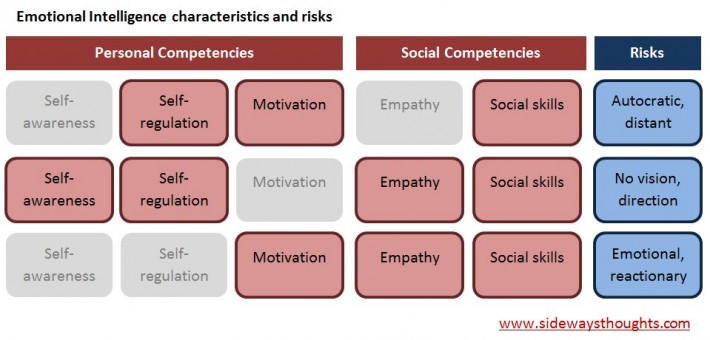Planning your New Year and passion for work: Goleman’s model for emotional intelligence and lessons from John Lauer

December holidays once again present the opportunity to pause, evaluate our previous calendar year, and decide on the type of world we choose to create over the next twelve months. As we consider the past twelve months, leaders and managers in organisations can ask to what extent we have influenced our environments and to what extent we are now a reflection of those environments. Our response depends on the degree in which we exhibit empathy and emotional intelligence.
Understanding empathy and embracing emotional intelligence
Empathy, the ability to understand and share the feelings of others, is critical to leading people. Empathy is referred to as the most powerful leadership tool, the single-most important skill in business today, and is said to have the potential to change the world. Empathy alone, however, has little impact if not combined with emotional intelligence.
Emotional intelligence is described as:
“abilities such as being able to motivate oneself and persist in the face of frustrations; to control impulse and delay gratification; to regulate one’s moods and keep distress from swamping the ability to think; to empathize and to hope.”
Emotional intelligence is critical for leading organisations, is said to boost productivity and is valued even over IQ. The connection between empathy and emotional intelligence can be found when reviewing Goleman’s five competencies he proposed comprise emotional intelligence, which include three personal competencies and two social competencies.
The three personal competencies are:
- Self-Awareness (“knowing one’s internal states, preferences, resources, and intuitions”);
- Self-Regulation (“managing one’s internal states, impulses, and resources”); and
- Motivation (“emotional tendencies that guide or facilitate reaching goals”).
The other two social competencies include:
- Empathy (“Awareness of others’ feelings, needs, and concerns”); and
- Social Skills (“Adeptness at inducing desirable responses in others”).
All five competencies are critical. Without the benefit of actual measurement, we can all couch-critique ourselves and leaders we have worked with.

A leader who is self-regulated and motivated with ability to affect change but lacks self-awareness and empathy can be autocratic and distant as they steamroll their agenda over people with whom they are not connected. A leader who understands and responds to people and the environment and has the ability to affect change but lacks motivation can leave people disillusioned without consistent vision or direction. A leader who empathises and has motivation but lacks self-regulation and self-awareness may not have the capacity to transform the inputs from the environment into change but rather emotionally reacts to the situation.
Learning from John Lauer
To this last point, I am reminded of an excerpt from a 2002 Harvard Business Review article titled “Reawaken Your Passion for Work”:
“I’m not the person I want to be.”
Some people gradually adjust to the letdowns, frustrations, and even boredom of their work until they surrender to a routine that’s incompatible with who they are and what they truly want. Consider, for instance, John Lauer, an inspirational leader who took over as president of B. F. Goodrich and quickly captured the support of top executives with his insight into the company’s challenges and opportunities, and his contagious passion for the business.
But after he’d been with the company about six years, we watched Lauer give a speech to a class of executive MBA students and saw that he had lost his spark. Over time, Lauer had fallen in step with a corporate culture that was focused on shareholder value in a way that was inconsistent with what he cared about. Not surprisingly, he left the company six months later, breaking from corporate life by joining his wife in her work with Hungarian relief organizations. He later admitted that he knew he wasn’t himself by the end of his time at B. F. Goodrich, although he didn’t quite know why.
How did Lauer stray from his core? First, the change was so gradual that he didn’t notice that he was being absorbed into a culture that didn’t fit him. Second, like many, he did what he felt he “should,” going along with the bureaucracy and making minor concession after minor concession rather than following his heart. Finally, he exhibited a trait that is a hallmark of effective leaders: adaptability. At first, adapting to the corporate culture probably made Lauer feel more comfortable. But without strong self-awareness, people risk adapting to such an extent that they no longer recognize themselves.
After Lauer’s departure from a US$500k per year position in 1994 at age 55, he pursued a Ph.D. critiquing the influence of excessive executive pay on society. Lauer put his theory into practice in his zero-salary CEO role with marine transport and resources company Oglebay Norton in 1997. The position lasted six years, much like the B. F. Goodrich role. The outcome does not appear to be as glamorous as the start, with Lauer’s strategy of expansion and debt acquisition described in one article as “The Wreck of the Oglebay Norton”.
Being in the situation versus becoming the situation
I wonder if Lauer once again in his Oglebay position felt as though he had “fallen in step with a corporate culture that was focused on shareholder value in a way that was inconsistent with what he cared about”. His strategy of rapid expansion has been criticized, but was he creating a situation and culture aligned with his values? The 2002 HBR article, which came out before Lauer’s 2005 exit from Oglebay, does quote one of John’s executives as saying “John raises our spirits, our confidence, and our passion for excellence.” and that during his time Oglebay Norton was featured in Fortune, BusinessWeek, and the Wall Street Journal. I wonder how much of Lauer’s challenges were his environment and how much, like all of us, he brought with him.
I often question the extent that I reflect my observations of the environments in which I operate versus how much I create the environments I want to see. My perception is that an unchecked profit-driven commercial mandate lends itself to cynicism, negativity, blame, selfishness and fear. This is in contrast to the world I would say I wish to create, one of positivity, graciousness, accountability, gratitude, and hope.
Axioms come to mind as I consider this dichotomy, such as “Be the change you want to see.” and “What you focus on you create.” As the Lauer depiction describes, it is easy to lose sight of these axioms due to the gradual nature of compromise, commercial pressure of what “should” be, and adapting to fit into the environment.
Strategies for Renewal
It is not as though the five emotional intelligence competencies are on/off propositions. Rather, we are strong or weak in each of the areas. Pressures in our situations wear away at one or more of the weak points. This wearing away can result in conformance as our resiliency to unwanted change diminishes.
The HBR article mentioned previously provides a few strategies for renewing energy and building up resiliency to unwanted change. These include:
- Call a time-out, taking time off to refresh and take stock;
- Follow a program, such as through a structured academic institution or development course;
- Create “reflective structures”, such as meditating or through executive peer or mentoring groups, building in times in the day, week, month and year for reflecting on what is working and what is not working; and
- Work with a coach or someone who can provide unbiased external insight.
The holiday time for me brings frustration at sacrifices I should not have made and concessions I should not have given. Yet it also fills me with hope in the change I believe I can make in the next twelve months. I look forward to another twelve months with lessons learned from those such as Lauer who have gone before me, a reflection on my own strengths and weaknesses of emotional intelligence competencies, and strategies in place for renewal to maintain the course.
I hope my sideways thoughts benefit you in your own journey over the next twelve months as you change your world into a better place for all involved. As a first reflective step, I welcome you to combine your traditional intelligence with your emotional intelligence and share your thoughts in the comments below.

Well structured and thoughtful. EI is so often overlooked in both our personal and professional lives…!
Thanks Marcel. Yes, I agree. And the value is just as critical in each sphere!